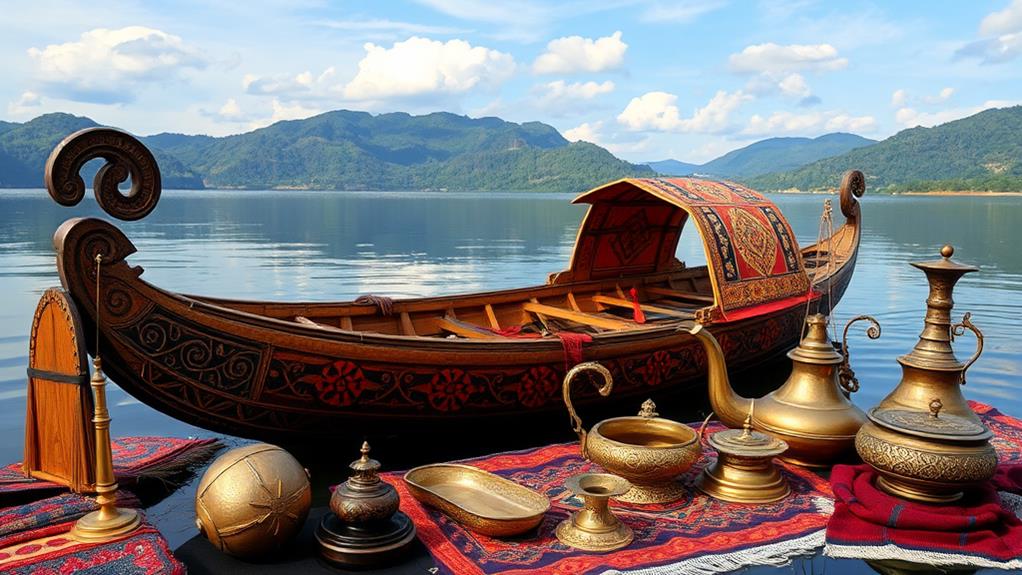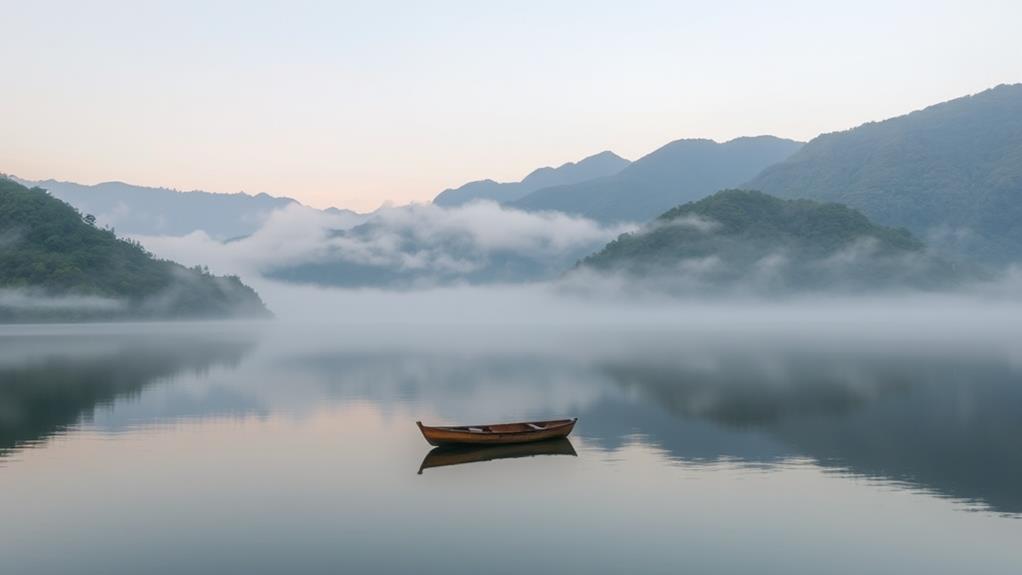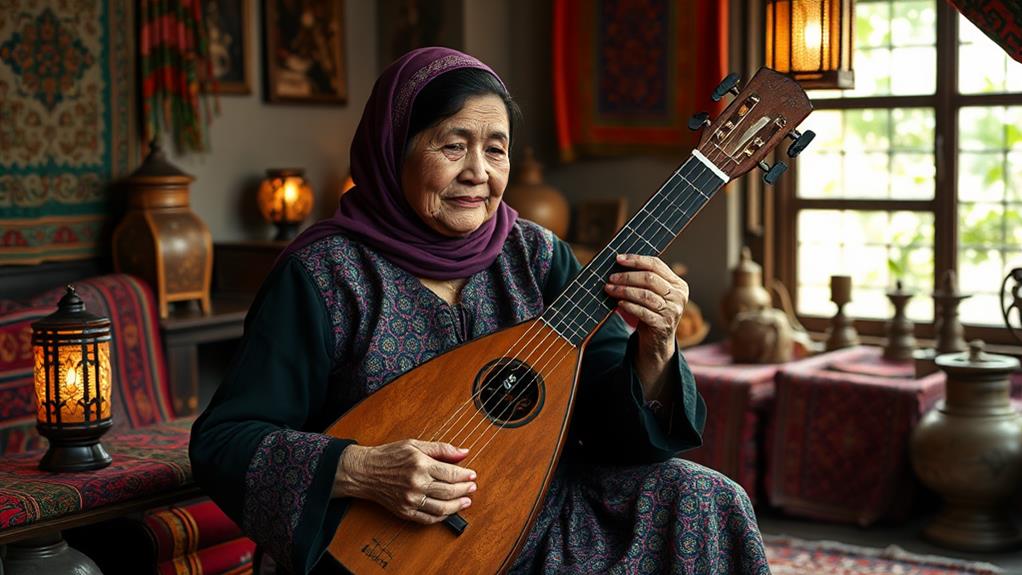The Maranao people's culture and traditions are deeply rooted in Lake Lanao's majestic beauty. Their rich heritage is showcased through the Darangen Epic, a 17-cycle oral tradition that teaches bravery, social values, and ethical behavior through stories of legendary heroes and mythical creatures.
Maranao identity is a unique blend of Southeast Asian traditions and Islamic values, which is reflected in their intricate art, music, and dance. For example, their traditional okir art features geometric patterns and Arabic calligraphy, showcasing their Islamic influence.
Daily life revolves around subsistence farming, fishing, and strong family ties, with polygamy being a traditional practice. In fact, farming and fishing provide food for the community, while strong family ties ensure social support and cooperation.
Lake Lanao's significance extends beyond its geographical importance, as it supports local industries and tourism. The lake's bounty attracts tourists, generating income for the local economy.
However, this cultural heritage faces challenges in balancing modernity with preservation, as the Maranao people strive to maintain their traditions in the face of modernization.
Unveiling the Darangen Epic

The Darangen Epic: A Rich Cultural Heritage
In the heart of Maranao communal gatherings, the Darangen Epic is frequently shared, filling the air with resonant sounds. This ancient oral tradition has been passed down through generations, transporting listeners to a world of mythical heroes and historical events.
The epic consists of 17 cycles and approximately 72,000 lines, weaving together a rich tapestry of stories.
More than Entertainment
The Darangen Epic is more than just entertainment; it encodes Maranao customary law, social values, and ethical behavior. This significance earned it a spot on the Representative List of the Intangible Cultural Heritage of Humanity in 2008.
Traditional Performance
Traditionally, specialized performers transmit the Darangen orally, using their skilled memory and improvisation to bring the stories to life during communal events like weddings.
Music and dance enhance the experience, making it a unique and engaging form of storytelling.
Challenges and Preservation
However, the epic's archaic language and poetic forms present a challenge to understanding, highlighting the need for preservation efforts to safeguard this critical aspect of Maranao cultural heritage.
Maranao Identity and Roots
The Maranao people's cultural identity is deeply rooted in their history and connection to Lake Lanao. This connection has been ongoing for nearly 5,000 years, making Lake Lanao an integral part of their lives.
Their sense of self is shaped by a unique blend of Southeast Asian traditions and Islamic values. This blend is reflected in their historical influences and local customs, such as the traditional okir designs and the practice of Islam.
Lake Lanao serves as a vital resource for the Maranao people. It provides them with fish for food, water for agriculture, and materials for traditional crafts.
Historical events have played crucial roles in shaping the Maranao's cultural identity and social structures. For example, their resistance to colonial rule and the spread of Islam have contributed to their distinct cultural identity.
The Maranao people preserve their cultural heritage through oral traditions, arts, and rituals. For instance, their oral traditions include stories about their ancestors and the history of Lake Lanao.
Their connection to their heritage ensures the continuity of their cultural identity amid modern societal changes. This connection allows them to maintain their cultural practices and livelihoods despite the influence of modern society.
Cultural Expressions and Arts

The Maranao people's cultural expressions are a testament to their exceptional artistic skills and creativity.
Intricate designs and patterns characterize Maranao arts and crafts. For instance, okir or okkil motifs, which feature flowing geometric designs, are prominent in their decorative arts.
Maranao textiles also showcase highly systematized design motifs, such as sari-manok (cock) and naga (dragon/snake), which reflect the wearer's status and cultural identity.
Music and dance play significant roles in Maranao cultural expressions. Kulintang music, primarily played by women, highlights the community's unique musical traditions and social roles.
Cultural dances like Kasingkil (singkil) and Kapagaper are derived from the epic Darangen, serving as a medium for storytelling and preserving historical narratives.
The Maranao people's exceptional craftsmanship is also evident in their traditional homes, which are adorned with intricate carvings and ornate decorations.
These cultural expressions not only showcase the Maranao people's artistic skills but also provide a glimpse into their rich cultural heritage and traditions.
Traditions and Daily Life
Family and Community Ties
The Maranao people's daily life is rooted in strong family and community ties, which shape their social structures and relationships. These ties are strengthened by traditional practices, such as the emphasis on family pride and lineage in celebratory events known as kandialaga, which precede official wedding ceremonies (kakawing).
Islamic Influence
Islamic teachings significantly influence the Maranao people's moral and ethical values, as well as their observance of rituals that often align with agricultural cycles. For example, their daily routines and special occasions are often marked by prayers and recitations from the Quran.
Oral Traditions and Storytelling
The Maranao community actively preserves oral traditions and storytelling, which serve as vital means for cultural transmission and reinforcement of social norms across generations. These stories often highlight the importance of family, community, and Islamic values.
Economic Activities
Subsistence farming is a primary economic activity among the Maranao people, with crops such as rice, corn, and sweet potatoes being cultivated. Fishing in Lake Lanao also supports their livelihoods, providing a source of food and income.
Cultural Significance
These traditions, deeply ingrained in Maranao society, continue to play a significant role in shaping their daily lives and community bonds. They serve as a foundation for their social structures, relationships, and economic activities, ensuring the preservation of their unique cultural identity.
Lake Lanao's Significance

Lake Lanao stands majestically at an altitude of approximately 2,300 feet, earning its revered title as the largest lake in the Philippines and the "Mother of All Lakes" among the Maranao people.
Freshwater source and fishing hub: Lake Lanao provides a vital source of freshwater and supports local fishing activities, which are essential to the Maranao people's subsistence and cultural practices.
For instance, the lake is home to a variety of fish species, including the prized pangasius, which is a staple food for the local community.
Spiritual significance: Local folklore attributes the creation of Lake Lanao to a divine act led by Archangel Diabarail, emphasizing its connection to the Maranao's cultural identity.
This spiritual significance is reflected in the lake's role in traditional rituals and ceremonies, such as the pagana, a ritual feast that honors the lake's bounty.
Environmental importance: The Agus River, which flows from Lake Lanao, is essential for irrigation and hydroelectric power, underscoring the lake's importance to both the environment and the livelihoods of the Maranao people.
The river's hydroelectric power plants generate electricity for the region, while its waters irrigate the surrounding agricultural lands.
Cultural hub: Lake Lanao influences various traditional crafts and practices, including the creation of textiles and artworks that reflect Maranao aesthetics and heritage.
For example, the lake's serene waters inspire the intricate designs on inai textiles, a traditional Maranao craft.
Economic significance: The lake's resources support local industries, contributing to the economic well-being of the Maranao community.
The fishing industry, for instance, provides a significant source of income for many local families, while the lake's tourism potential generates revenue for the region.
Adaptation and Modernity
Preserving Cultural Identity in the Face of Modernity
The Maranao people, situated near Lake Lanao, strive to maintain their ethnic identity while adapting to modern societal influences.
Traditional crafts like weaving and woodcarving continue to thrive, despite the pressures of modernization. These crafts are essential to Maranao culture, and their preservation is crucial for the community's identity.
Educational initiatives are crucial for cultural continuity. Teaching traditional values to younger generations is vital for ensuring the continuation of Maranao culture in a rapidly changing world.
Community support and cultural initiatives are essential for revitalizing Maranao traditions, fostering a sense of pride and resilience against the influences of modernization.
Finding a balance between adaptation and preservation is key. The Maranao people strive to adapt to modernity while preserving their cultural heritage, ensuring their unique identity remains intact for generations to come.
Historical Legacy and Impact

The Maranao People's Historical Legacy
The Maranao people's historical legacy is deeply rooted in their connection to Lake Lanao, their sacred land, which has been their home for nearly 5,000 years.
This prolonged presence has allowed them to develop a unique cultural identity that's intricately tied to the lake.
Key Aspects of Their Historical Legacy
A Rich Cultural Identity: The Maranao people's cultural identity has been shaped by their connection to Lake Lanao and their resistance to colonial rule. The Maranao people’s traditional dances, music, and visual arts often revolve around themes of nature, community, and the heroic struggles of their ancestors. Their weaving and metalwork are highly regarded and reflect their rich cultural heritage. Additionally, the Maranao people have long celebrated their connection to the waterways of their homeland, as seen in the traditional event known as the cagayan river cruise. This event showcases the community’s deep connection to the landscape and its significance in shaping their cultural identity.
For example, their traditional dances and music are inspired by the lake's natural beauty.
Introduction of Islam: The introduction of Islam has deeply influenced the Maranao people's cultural practices and societal norms.
Islamic principles guide their daily lives, from prayer rituals to social customs.
Preservation of Heritage: The Maranao people have preserved their heritage through art, crafts, and festivals in Marawi City, the only Islamic city in the Philippines.
The city's architecture, food, and clothing are all testaments to their rich cultural heritage.
The Darangen Epic: The Darangen epic is a significant part of Maranao literature, celebrating their history and mythology.
This epic poem tells the story of their ancestors' bravery and struggle for independence.
Lake Lanao's Significance: Lake Lanao is a symbol of pride and autonomy, reflecting the Maranao people's historical resistance to colonial rule.
The lake represents their struggle for self-governance and their connection to their ancestors.
Maranao Society and Structure
Maranao Society is Built on Strong Family Ties
The Maranao society thrives on a complex web of familial and clan ties that foster strong community networks.
Polygamy is a traditional practice among Maranao males, often arranged by parents, with significant roles played by dowry negotiations in marriage customs.
Leadership is Guided by Elders and Customary Laws
Leadership within Maranao communities is guided by elders who reference customary laws encoded in cultural epics, such as the Darangen, to resolve disputes and uphold social norms.
Islamic Teachings Influence Moral and Ethical Standards
Maranao society places a high value on Islamic teachings, which influence moral and ethical standards, as well as traditional rituals that align with agricultural cycles and community events.
For example, the Maranao people celebrate Islamic holidays like Eid al-Fitr and Eid al-Adha, which are significant in their cultural calendar.
Cultural Identity is Rooted in History and Tradition
The cultural identity of the Maranao is deeply intertwined with their historical resistance to colonial influences, fostering a resilient sense of heritage and pride in their unique customs and traditions.
Traditional dishes, such as pegon (steamed rice cake) and balbacua (stewed meat), are an integral part of Maranao gatherings, where stories of ancient epics are shared and passed down through generations.
What Cultural Experiences Can Visitors Expect at Balinsasayao Twin Lakes Natural Park?
Visitors at Balinsasayao Twin Lakes Natural Park can expect a tranquil and serene experience surrounded by lush forests and pristine waters. The natural park offers opportunities for hiking, birdwatching, and boating. Encounter diverse wildlife and immerse in the peaceful ambiance of the serene lakes natural park.
Preserving Cultural Heritage

Preserving the Darangen Epic
The Darangen epic, a cornerstone of Maranao cultural heritage, has been passed down through seven generations of oral tradition. However, modern influences now threaten its survival.
Training Specialized Performers
To ensure the Darangen's survival, specialized performers must be trained to maintain traditional singing during communal events. This will allow them to pass on their skills to younger generations, preserving the epic's traditional singing style.
Bridging Language Gaps
Efforts to bridge language gaps are necessary to preserve the Darangen's rich vocabulary and archaic forms. This will enable broader understanding and appreciation of the epic, as well as its cultural significance.
Revitalizing Cultural Initiatives
Cultural initiatives revitalizing Darangen performances and other Maranao traditions are vital. These initiatives combat the decreasing frequency of these practices due to changing lifestyles, ensuring the epic remains an integral part of Maranao culture.
Community Support and Engagement
Community support and engagement are essential for sustaining Maranao cultural heritage. This support ensures traditional customs, arts, and culinary practices are passed down through generations, preserving the Maranao people's unique identity.
Protecting Cultural Legacy
The Lanao indigenous group must come together to protect their cultural legacy. By recognizing the importance of preserving their unique heritage, they can ensure its survival for future generations.
Frequently Asked Questions
What Are the Cultures and Traditions of Maranao?
The Maranao people's culture is rich and vibrant, with festivals that showcase their love for music, dance, and art.
Their traditional crafts, such as okir-designed textiles, woodcarvings, and metalwork, demonstrate their skill and creativity.
Okir designs, for instance, are intricate and ornate patterns that adorn fabrics and other materials.
Their vibrant festivals often feature intricate performances, such as the kulintang ensemble, which highlights their musical heritage. The kulintang is a traditional instrument composed of gongs and drums that play a crucial role in Maranao cultural celebrations.
Their cultural identity is deeply rooted in their history, family values, and artistic expressions, making their traditions truly unique and fascinating. This is evident in their strong family bonds and respect for ancestors, which are reflected in their art, music, and storytelling.
Who Are the Maranao People of Lake Lanao?
The Maranao people are an ethnic group known for their strong family ties and cultural pride.
They have their own distinct language, which is a blend of Malay and Arabic influences. This language is a key part of their cultural identity and is still widely spoken today.
The Maranao people are one of the largest Islamic groups in the Philippines, and Islamic traditions and values are deeply rooted in their culture.
For example, they observe Islamic holidays such as Eid al-Fitr and Eid al-Adha, and many Maranao people make the pilgrimage to Mecca at least once in their lifetime. Their Islamic faith plays a significant role in shaping their daily lives and practices.
The Maranao people have a rich cultural heritage that has contributed to their unique identity.
Their traditional clothing, such as the malong, is a colorful and intricately designed garment that's worn on special occasions.
They're also known for their skilled craftsmanship, particularly in metalwork and woodcarving. These cultural practices have been passed down through generations and continue to be an important part of Maranao life.
What Is the Culture of Lanao?
Lanao's culture is a blend of Islamic traditions and indigenous practices. This unique cultural heritage is deeply rooted in community ties, family lineage, and traditional practices.
One such practice is polygamy, where a man can have multiple wives. Another significant tradition is dowry negotiations, where the groom's family presents gifts to the bride's family as a symbol of respect and gratitude.
The region is known for its artistic flair, showcased through intricate woodcarvings, brassware, and okir-adorned textiles. The malong, a traditional textile, is a symbolic representation of the Maranao people's identity and is often worn during special occasions.
Spicy flavors dominate the local cuisine, with communal meals playing a significant role in celebrations. During special events, families gather together to share food and strengthen community bonds.
Lake Lanao is a vital resource and a symbol of the Maranao people's identity. It serves as a source of livelihood, providing fish and other aquatic resources that are essential to the local economy.
What Is the Legend of Lake Lanao All About?
The Legend of Lake Lanao is a mythical tale that explains the lake's creation.
According to this legend, angels led by Archangel Diabarail created Lake Lanao to prevent the world from turning upside down.
The angels formed the lake to maintain balance and harmony in the world.
The legend also links the lake's creation to the Four Winds, which are said to have formed the Agus River as the lake's outlet.
The Agus River is the primary outlet of Lake Lanao, and it plays a crucial role in maintaining the lake's water level and ecosystem.
These sacred stories highlight the lake's mystical origins and emphasize the Maranao people's deep reverence for nature.
The legend showcases the lake's significance as a vital resource and a symbol of the people's connection with the natural world.